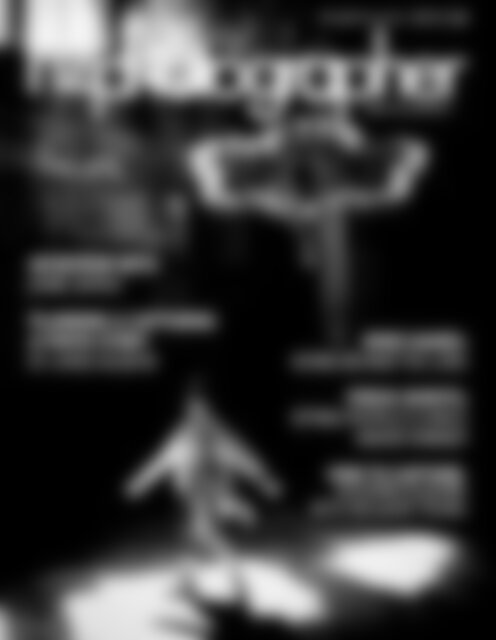NZPhotographer Issue 18, April 2019
As of December 2022, NZPhotographer magazine is only available when you purchase an annual or monthly subscription via the NZP website. Find out more: www.nzphotographer.nz
As of December 2022, NZPhotographer magazine is only available when you purchase an annual or monthly subscription via the NZP website. Find out more: www.nzphotographer.nz
Create successful ePaper yourself
Turn your PDF publications into a flip-book with our unique Google optimized e-Paper software.
Brought to you by<br />
ISSUE <strong>18</strong>, <strong>April</strong> <strong>2019</strong><br />
INTERVIEW WITH<br />
EMRE SIMTAY<br />
PLANNING & CAPTURING<br />
A PHOTO STORY<br />
BY JAMES GILBERD<br />
MIND GAMES:<br />
HIDING BEHIND THE LENS<br />
FRESH SHOOTS:<br />
SPRING PEOPLE'S CHOICE<br />
AWARD WINNER<br />
HOW TO CAPTURE:<br />
AUTUMN COLOURS<br />
WITH RICHARD YOUNG<br />
<strong>April</strong> <strong>2019</strong><br />
1
WELCOME TO ISSUE <strong>18</strong> OF<br />
NZ PHOTOGRAPHER MAGAZINE<br />
HELLO EVERYONE,<br />
In this issue, we are putting the<br />
focus on Street Photography.<br />
Get inspired to walk the streets<br />
with your camera to capture<br />
everyday life at home and<br />
abroad in our interview with<br />
Emre Simtay and in Behind the<br />
Shot with Mary Hutchinson where<br />
you'll learn what makes street<br />
photography so interesting.<br />
If you've always been shy of<br />
taking candid photos on the<br />
street, Ana gives some insight<br />
into getting more comfortable in<br />
approaching people so you've<br />
no excuse not to give it a go!<br />
Think you've got a great street<br />
photography shot already?<br />
Read our photo review and see if<br />
you could improve your own shot<br />
with the tips and tricks offered.<br />
We also have James Gilberd sharing his thoughts on how to put together<br />
a photo story, explaining that a set of 6 images can convey an event,<br />
emotion, or place better than a single image. Plus, Brendon takes us on<br />
a return journey to Punakaiki as he enjoys time out in nature walking the<br />
river and beach. We also get to learn about the photographer who won<br />
the Fresh Shoots People's Choice Award with her 'After the Storm' poppies<br />
photo.<br />
Emily Goodwin<br />
Editor NZ Photographer<br />
General Info:<br />
<strong>NZPhotographer</strong> <strong>Issue</strong> <strong>18</strong><br />
<strong>April</strong> <strong>2019</strong><br />
Cover Photo<br />
Emre Simtay<br />
Publisher:<br />
Excio Group<br />
Website:<br />
www.excio.io/nzphotographer<br />
Group Director:<br />
Ana Lyubich<br />
ana@excio.io<br />
Editor:<br />
Emily Goodwin<br />
Graphic Design:<br />
Maksim Topyrkin<br />
Advertising Enquiries:<br />
Phone 04 889 29 25<br />
or Email hello@excio.io<br />
2 <strong>NZPhotographer</strong>
REGULAR CONTRIBUTORS<br />
Brendon Gilchrist<br />
Brendon is the man<br />
behind ESB Photography.<br />
He is an avid tramper<br />
who treks from sea to<br />
mountain, and back<br />
again, capturing the<br />
uniqueness of New<br />
Zealand’s unforgiving<br />
landscape.<br />
Ana Lyubich<br />
Co-founder of Excio,<br />
Ana's photography<br />
journey started many<br />
years ago with one of the<br />
first Kodak film cameras.<br />
She loves exploring the<br />
unseen macro world and<br />
capturing genuine people's<br />
emotions.<br />
Richard Young<br />
Richard is an awardwinning<br />
landscape and<br />
wildlife photographer who<br />
teaches photography<br />
workshops and runs<br />
photography tours. He<br />
is the founder of New<br />
Zealand Photography<br />
Workshops.<br />
nzphotographer nzp_magazine nzp@excio.io<br />
© <strong>2019</strong> <strong>NZPhotographer</strong> Magazine<br />
All rights reserved. Reproduction of any material appearing in this magazine in<br />
any form is forbidden without prior consent of the publisher.<br />
Disclaimer:<br />
Opinions of contributing authors do not necessarily reflect the<br />
opinion of the magazine.<br />
<strong>April</strong> <strong>2019</strong><br />
3
CONTENTS<br />
<strong>18</strong><br />
10<br />
6<br />
9<br />
10<br />
14<br />
<strong>18</strong><br />
26<br />
28<br />
30<br />
32<br />
9<br />
INTERVIEW WITH EMRE SIMTAY<br />
PUNAKAIKI 2.0<br />
by Brendon Gilchrist<br />
HOW TO CAPTURE: AUTUMN COLOURS<br />
by Richard Young<br />
IMPROVING YOUR PHOTOGRAPHY<br />
PHOTO REVIEW SESSION<br />
FRESH SHOOTS: SPRING PEOPLE'S<br />
CHOICE AWARD WINNER<br />
INTERVIEW WITH EMRE SIMTAY<br />
PLANNING AND CAPTURING A PHOTO STORY<br />
By James Gilberd<br />
BEHIND THE SHOT<br />
with Mary Hutchinson<br />
MIND GAMES: HIDING BEHIND THE LENS<br />
by Ana Lyubich<br />
PORTFOLIO: BEST READERS'<br />
SUBMISSIONS THIS MONTH<br />
IMPROVING YOUR<br />
PHOTOGRAPHY<br />
PHOTO REVIEW SESSION<br />
MIND GAMES:<br />
HIDING BEHIND THE LENS<br />
HOW TO CAPTURE: AUTUMN COLOURS<br />
30
F2.8, 20s, ISO10000<br />
Punakaiki 2.0<br />
by Brendon Gilchrist<br />
In <strong>Issue</strong> 4, I touched on the small west coast town of<br />
Punakaiki, or what I called Jurassic Park. Well, I’ve been<br />
back! It is rare for me to be on the West Coast aka the<br />
Wet Coast but thankfully, I got lucky with the weather<br />
with only a little bit of rain.<br />
Punakaiki is surrounded by limestone landscapes of<br />
many different forms including the mysterious and<br />
popular pancakes rocks, so perfectly stacked upon<br />
each other that no one knows how/why they formed<br />
exactly like that. These pancake rocks and the blowholes<br />
are the main attraction of Punakaiki and amazingly are<br />
still free to walk around and enjoy.<br />
By day this place is always busy, usually busier at high tide<br />
just in case the swells are coming from the right direction<br />
to create an updraft of water and air for the blowholes<br />
to activate. But at night there are very few people<br />
around, maybe 1 or 2.<br />
I decided to visit the platform that overlooks the<br />
pancake rocks one night to capture the milky way over<br />
the mountains. It was a good night to continue playing<br />
with my new Nikkor 14–24 2.8g. I have been missing out<br />
on that extra 14mm of focal length for a long time now<br />
and am happy to be able to shoot ultra wide angled<br />
shots.<br />
On the one rainy morning I got when I visited, I walked<br />
beside the river on the beautiful and well maintained<br />
Pororari River Track with the towering limestone cliffs<br />
that rise up to 100 metres above the water. I don’t know<br />
about you but I find walking in the rain so refreshing, the<br />
smell of fresh rainwater pattering on the tree leaves,<br />
slowly dripping down to the forest floor, it’s refreshing to<br />
be in that moment when nothing else matters but that<br />
sense of being in nature and enjoying what you are<br />
about to do – Capture some moody landscapes!<br />
6 <strong>NZPhotographer</strong>
F11, 1/250s, ISO64<br />
F16, 1/3s, ISO31
As the track weaves besides the river, taking you<br />
on a magical journey through a land locked in time<br />
that only nature can touch, you come to viewing<br />
points overlooking the river and there are a couple of<br />
opportunities to get down to the river edge or even walk<br />
into the river to take some photos looking up the river<br />
from a completely different angle that many won’t see.<br />
There’s so much to photograph and marvel at from the<br />
nikau palm trees to the native flaxes and the walls of<br />
limestone leading you out up the river into an unknown<br />
world not forgetting the wildlife with the native Kereru<br />
munching on the berries. I found an amazing looking<br />
tree to photograph, it sits right beside the river and towers<br />
above all the other trees in an iconic location of this<br />
area.<br />
Sunsets can be very epic on the West Coast but on my<br />
last evening it was raining on and off and I thought about<br />
not going out to shoot at the pancakes as it seemed like<br />
no light was going to shine through and that it would be<br />
a boring dull grey sunset – I’m so glad I went out anyway!<br />
The sunset was perfect with a gap in the cloud allowing<br />
enough light to shine through creating some epic light<br />
rays and a hint of golden sun colours. It was hard to<br />
believe there were only a few other photographers here<br />
witnessing this event but I’m glad to have captured this<br />
and have my personal take on Punakaiki at sunset as<br />
I love storms and sunsets and I’ve been wanting a sunset<br />
shot like this for a long time but actually thought it was<br />
too easy and not my style. As I grow as a photographer<br />
and a person I learn to appreciate the easy and the not<br />
so easy locations, everything is unique and different for its<br />
own different reasons.<br />
Driving from Punakaiki on the Great Coast Ride you get<br />
the sense that you’re in a forest driving beside the coast.<br />
It’s hard to keep your eyes on the road at times because<br />
the impressive view is always evolving into something<br />
new, the coastline changing from charming calm bays<br />
to rugged coastline with large rock outcrops.<br />
This small area has everything you need to survive and<br />
everything you want as a photographer. I assure you that<br />
unique inspiration awaits so pack your bags because this<br />
place will blow you away, whether it’s raining or not!<br />
A TIP FOR SEEING THE BLOW HOLES:<br />
• Photography is about planning so if you want the<br />
shot you need to plan to get it. To see the Punakaiki<br />
Pancake rocks blow holes in action the best swells<br />
you need to look for are at high tide though not<br />
when there is a south-westerly swell. Saying this, they<br />
are not always blowing at high tide so luck, patience,<br />
and perseverance are required!<br />
ASTRO PHOTOGRAPHY TIPS:<br />
• Always shoot in raw, the level of detail, especially in<br />
the shadows, will outweigh anything shot in JPG or<br />
any other format.<br />
• To find focus in the pitch black is very hard. Use<br />
the live view and zoom in (on the screen) onto the<br />
brightest star, manual focus and twist the focus ring<br />
until the star is nice and sharp.<br />
F16, 1/5s, ISO64
HOW TO CAPTURE: AUTUMN COLOURS<br />
Capture the best of this year's Autumn colours with tips by Richard Young<br />
Autumn offers one of the best times for photography with landscapes that are full of burnt oranges, warm<br />
yellows, and other beautiful autumn shades. Shooting during the ‘golden hour’ in autumn will add a soft, warm<br />
glow to colours that are already vibrant and also increases the sense of atmosphere that is conveyed by the<br />
scene. Mood is often key when photographing in autumn, so don’t be afraid to go out with your camera on<br />
rainy days. Forests, lakes, and rivers are good options to photograph in overcast conditions.<br />
Reflections: Bright colours and bold shapes become<br />
abundant in autumn, reflections can be used to<br />
enhance these elements.<br />
Abstracts: Instead of photographing a grand view,<br />
try capturing a smaller more intimate shot. Make the<br />
most of the fallen leaves and look for little details,<br />
taking time to scout the scene trying to find a subject<br />
that catches your eye.<br />
Autumn Colours at Lake Wanaka<br />
Trees: Look for a single tree in a wide sweeping<br />
landscape, this can create a dramatic shot. Also, try<br />
shooting under the forest canopy looking up at the<br />
foliage or using natural features to frame your subject.<br />
Use a Circular Polariser: This filter is your best friend<br />
in autumn whether you’re in the forest or capturing<br />
an open scenic view. On rainy or overcast days a<br />
polariser will remove unwanted glare from wet shiny<br />
leaves.<br />
VISIT SOME OF THE SOUTH ISLAND BEST AUTUMN LANDSCAPE LOCATIONS ON A 7-DAY SOUTH ISLAND<br />
PHOTOGRAPHY TOUR IN APRIL WITH NEW ZEALAND PHOTOGRAPHY WORKSHOPS
Improving Your Photography<br />
Photo Review Session<br />
by Excio<br />
F9, 1/800s, ISO400<br />
REVIEW BY:<br />
Almin Vranac<br />
THE BEGINNING OF THE DAY BY DEJAN KIJEVCANIN<br />
THE MAIN STREET IN THE OLD TOWN IN BELGRADE, SERBIA<br />
INITIAL THOUGHTS AND PLUS POINTS<br />
The first thing I like about this photo is that it's done<br />
in black and white which enhances the edges of<br />
the buildings and the patterns. Shooting street and<br />
architecture photography in black and white is a<br />
really common and well received technique in the<br />
photography world.<br />
The second thing which I also love is the lighting in<br />
this picture. To be precise, the great thing about it is<br />
how the centre of the scene is lit by natural sunlight,<br />
making it a bit overexposed (but not too much)<br />
while the sides of the photo are in the shadows and<br />
a bit darker. This gives you the feel like you're really<br />
there, giving the viewer a better experience, which is<br />
something that we should strive for with every photo.<br />
10 <strong>NZPhotographer</strong>
POSSIBLE<br />
IMPROVEMENTS<br />
The first thing that catches<br />
my eye right away about<br />
this photo is the mistake of<br />
not using the rule of thirds<br />
properly or not using it at<br />
all. Let's take a look at the<br />
photo explanation:<br />
We should always aim to<br />
put our objects on vertical<br />
lines or on the meeting<br />
points where vertical and<br />
horizontal lines meet (this is<br />
for smaller objects). For this<br />
particular photo, we should<br />
be putting the ends of the<br />
side by side buildings on<br />
each of the vertical lines<br />
to make it more visually<br />
pleasing.<br />
Another pretty significant thing<br />
to improve in this photo is the<br />
asymmetry.<br />
As we can see from the photo<br />
explanation, we should base<br />
our symmetry around the<br />
imagined line that is set in the<br />
middle of the gap between<br />
the two parallel buildings.<br />
What does that mean? It<br />
means that this line should<br />
go through the center of<br />
our scene, slicing it into two<br />
identical halves. We should<br />
always tend to recreate what<br />
is on the left side of the line on<br />
the right side too. Of course,<br />
this is only applicable if the<br />
scene is set up to allow us to<br />
do that but this photo with the<br />
two parallel buildings of similar<br />
sizes is the perfect occasion.<br />
<strong>April</strong> <strong>2019</strong><br />
11
In this photo there are two main<br />
ways we can achieve this:<br />
1. For the first option, the best one,<br />
we should adjust the scene setup<br />
before we take the shot. What<br />
do I mean? Well, in this case, that<br />
means that we should move a few<br />
steps to the left so the centre of the<br />
gap between the two buildings is<br />
right in the middle of our scene.<br />
Since this way of achieving a<br />
symmetrical scene isn't always<br />
an available option (for various<br />
reasons), there's an alternative.<br />
2. Cropping. When the photo is<br />
already taken and we don't have<br />
another one that is shot better, the<br />
only way to achieve symetry is to<br />
crop the photo according to our<br />
reference line. That means that<br />
we should crop the photo until our<br />
imaginary symmetrical line gets to<br />
the middle of our newly cropped<br />
photo. See the photo explanation<br />
on the right.<br />
As we can see, the cropped photo below looks a lot more professional<br />
and more visually appealing.<br />
Ready to take your photography to the next level? Get friendly yet informative tips and advice when you join Excio.
A new generation community<br />
for passionate photographers and image lovers<br />
Proven to increase awareness of your photography,<br />
improve your skills and give you<br />
the confidence to succeed.<br />
LEARN MORE<br />
www.excio.io
FRESH SHOOTS: SPRING PEOPLE'S C<br />
Vandy Pollard<br />
14 <strong>NZPhotographer</strong>
HOICE AWARD WINNER:<br />
POPPIES<br />
F2.8, 1/1000s, 70mm<br />
‘Beauty after the storm’<br />
<strong>April</strong> <strong>2019</strong><br />
15
INTERVIEW WITH VANDY POLLARD<br />
HI VANDY, PLEASE INTRODUCE YOURSELF...<br />
I live in Wellington on the South Coast, Lyall Bay and<br />
have always been a keen amateur photographer.<br />
I completed a Bachelor of fine arts (BFA) and majored in<br />
Graphic Design/Photography back in 1985 at Canterbury<br />
University Art School where I was using an Olympus OM2n<br />
which was a single lens reflex film system camera.<br />
I have become more serious about my photography<br />
in the last couple of years since purchasing my first<br />
DSLR, a 80D Canon.<br />
I have a post-graduate diploma in Secondary<br />
teaching but work as a regional manager covering<br />
Central North Island for the National Advocacy Trust/<br />
Health and Disability Consumer Advocacy Service<br />
which is a service provided under the Health and<br />
Disability Commissioner Act 1994.<br />
HOW WOULD YOU DESCRIBE YOURSELF AS A<br />
PHOTOGRAPHER?<br />
I consider myself a serious amateur photographer and<br />
in my spare time photograph most days.<br />
I’m a keen gardener but despite my winning shot for<br />
the people’s choice awards, flowers/plants are not my<br />
usual subject matter.<br />
My main inspiration comes from nature as I live on the<br />
South Coast of Wellington, love walking and enjoy<br />
varied landscape and birdlife on the coast. I also<br />
frequently visit Zealandia Ecosanctuary in Wellington<br />
to photograph the wildlife/birds.<br />
TELL US ABOUT YOUR POPPIES SHOT...<br />
I had purchased an EF 70-200mm f 2.8L IS II lens and<br />
was keen to try it out with my 80D.<br />
I entered this particular photograph of the last of the<br />
poppies with just a few petals precariously hanging onto a<br />
hint of summer colour as the change of seasons intrigued<br />
me. I found such beauty in the spent blooms in sharp<br />
contrast to the richness of the trees in the background.<br />
I chose to use a shallow depth of field to focus on the<br />
poppies in the foreground and to achieve a soft focus<br />
for the background trees. My composition is almost as<br />
shot in camera with only minor cropping/editing.<br />
HOW DID YOU FEEL WHEN YOU FOUND OUT<br />
YOU HAD WON THE PEOPLE’S CHOICE?<br />
I was incredibly excited as I haven’t entered many<br />
competitions before and I had actually forgotten I<br />
had entered this photograph! Winning the people’s<br />
choice was special as people liked the photo I had<br />
entered.<br />
HOW DID YOU FIND OUT ABOUT THE<br />
COMPETITION AND WHAT MOTIVATED YOU<br />
TO ENTER?<br />
I attended a Wellington Photography meet up<br />
group hosted by yourselves at the Wellington<br />
Botanic Gardens in October last year as I<br />
wanted to push myself out of my comfort zone of<br />
photographing wildlife and landscape, but had<br />
also learned of the Fresh Shoots photography<br />
competition through the Wellington Photographic<br />
Society. I entered a few photographs from this<br />
meetup walk and another workshop run by the<br />
Wellington Photographic Society at the Botanic<br />
Gardens that month.<br />
HAS WINNING THE PEOPLES CHOICE<br />
INSPIRED YOU TO TAKE YOUR<br />
PHOTOGRAPHY FURTHER?<br />
Winning has definitely inspired me to take a few<br />
more risks with my photography, to not become<br />
complacent with my usual subject matter, and to<br />
explore other places with my camera.<br />
Since submitting my photo to the competition I<br />
have completed a few workshops. One with wildlife<br />
photographer Chris Helliwell on a trip to Zealandia<br />
and most recently a one day long exposure<br />
workshop hosted by Richard Young.<br />
Learning new techniques and photographing/<br />
learning from others has helped me grow as a<br />
photographer and I am keen to find an opportunity<br />
to enter more competitions and share my<br />
photographs.<br />
WHAT ADVICE WOULD YOU GIVE TO OTHER<br />
PHOTOGRAPHERS?<br />
Don’t be afraid to get out of your comfort zone.<br />
Find other people who also enjoy photography and<br />
who share your passion - join a local photography<br />
group or society, find local meetups, don’t be<br />
afraid to ask for help, exchange ideas, share your<br />
photos, explore, and experiment. Be brave, push<br />
your own boundaries, and continue to challenge<br />
yourself and grow.<br />
www.instagram.com/coastal_wanderer_nz<br />
The Fresh Shoots Autumn season competition is now open - Submit your photos from Wellington<br />
Botanical Gardens and it could be your photo featured here in a future issue!
FRESH SHOOTS<br />
PHOTO COMPETITION<br />
We’re inviting photographers to highlight all the wonderful things that make the Wellington<br />
Botanic Garden much more than a garden, while encouraging photographers to focus on<br />
the garden season by season.<br />
For prizes and full Terms & Conditions see: www.excio.io/freshshoots<br />
The competition is split into quarterly competitions based on each of the seasons:<br />
Summer Autumn Winter<br />
15 December -<br />
22 March <strong>2019</strong><br />
23 March -<br />
21 June <strong>2019</strong><br />
22 June -<br />
20 September <strong>2019</strong><br />
CATEGORIES<br />
NATURE<br />
PEOPLE &<br />
EVENTS<br />
CREATIVE<br />
PARTNERS<br />
<strong>April</strong> <strong>2019</strong><br />
17
Interview with<br />
Emre Simtay<br />
EMRE, PLEASE TELL US A BIT ABOUT YOU…<br />
I was born in Germany, but returned to my parents’ native<br />
Turkey in my late childhood and studied there. I came out<br />
to New Zealand in 2005 and attended Victoria University in<br />
Wellington to study Computer Science and upon graduation,<br />
began a career as a software developer.<br />
WHEN AND HOW DID YOU START LEARNING<br />
PHOTOGRAPHY?<br />
I developed an interest in photography with my wife’s<br />
encouragement about seven years ago. I taught myself all about<br />
taking photos and since then I have been constantly taking<br />
photos and documenting what’s happening around me.<br />
HOW WOULD YOU DESCRIBE YOUR STYLE OF<br />
PHOTOGRAPHY?<br />
I don’t think I ever really focused on one particular style or<br />
category. I just enjoy taking what attracts my eye and adjust to<br />
the current environment. As I am mostly out shooting in the<br />
city, I usually do street, documentary style, urban and portrait<br />
photography. Extraordinary things never fail to catch my eye.<br />
I constantly observe my surroundings and anything that tells a<br />
story about society or the world around me will get captured on<br />
my camera.<br />
WHAT CAMERAS DO YOU HAVE?<br />
Currently, I have a full frame Sony A7ii with Zeiss 35mm F2.8<br />
and Canon FD f1.2 lens. The camera I always carry with me is<br />
an APS-C Fujifilm XF‐10. It has f.28 <strong>18</strong>mm fixed prime lens with<br />
APS-C crop sensor and the snapshot feature, very small and very<br />
light compact camera with all the features I can find on a DSLR.<br />
I also have film cameras, a medium format Yashica 635 and a<br />
35mm Canon AE‐1 with 50mm f1.8 prime lens but I don’t do film<br />
photography very often as I am not a patient person and usually<br />
do it only on weekends when I have the time to fiddle around!<br />
WHAT MOTIVATES YOU TO PICK UP YOUR<br />
CAMERA, ESPECIALLY WHEN ‘LIFE’ TAKES<br />
OVER…<br />
The thought of looking through my photos in the future and<br />
seeing how life around us has evolved motivates me. It makes<br />
me go out to do photography and makes me feel like I should be<br />
shooting even more.<br />
TELL US ABOUT THE COVER PHOTO.<br />
This was taken whilst we were showing our Wellingtonian<br />
friends around Istanbul. We went to the Hagia Sophia museum<br />
and there was a tourist lady posing for her friend. I liked how<br />
the light was highlighting her dance with the sunlight so took a<br />
photo!<br />
WOULD YOU SAY THAT YOU’RE ALWAYS<br />
LEARNING AND PUSHING YOURSELF TO<br />
CAPTURE BETTER IMAGES? HOW DO YOU DO<br />
THAT?<br />
I guess so! Yes, I try to push myself to capture better images.<br />
I sometimes take a short break from photography and go<br />
through all my photos and re-evaluate them. I always ask myself<br />
what makes a good photo and the answer to this question has<br />
changed many times since I started shooting.<br />
When I first started photography, I mostly focused on using<br />
negative spaces correctly, having the right exposure and making<br />
one nicely composed beautiful photo then I realised I needed<br />
to study my subject better and try different perspectives and<br />
I believe this improved my photography a lot.<br />
Once I started feeling confident, I decided I needed to shoot<br />
more often so I did photography walks every day for couple<br />
years and focused on just taking photos – I mean without much<br />
thinking, whatever I found interesting I took a photo of. I would<br />
then go through all my photos to analyse them and think about<br />
how I could improve them and what I would do differently next<br />
time.<br />
WE DID A BEHIND THE SHOT FEATURE WITH YOU<br />
IN ISSUE 6 (APRIL 20<strong>18</strong>), HOW WOULD YOU<br />
SAY YOUR PHOTOGRAPHY HAS CHANGED/<br />
IMPROVED SINCE THEN?<br />
My photography has changed a little. I carry more lightweight<br />
cameras and focus less on the aesthetic and more on the story<br />
aspect of photography, trying to produce more meaningful<br />
photos.<br />
<strong>18</strong> <strong>NZPhotographer</strong>
<strong>April</strong> <strong>2019</strong><br />
19
I prefer my photos tell a story and leave people imagining what is<br />
going on behind the scene however, I still photograph beautiful<br />
looking landscapes and whatever takes my attention but my goal<br />
is to make a photo that tells a story.<br />
YOU’VE RECENTLY RETURNED FROM A TRIP TO<br />
TURKEY, HOW DID STREET PHOTOGRAPHY IN<br />
TURKEY DIFFER FROM STREET PHOTOGRAPHY IN<br />
NEW ZEALAND?<br />
Taking photos in Turkey is much easier than New Zealand. You<br />
can be way more productive because cities like Istanbul are<br />
much more dynamic than here, there is a lot happening. In<br />
Turkey, people don’t seem to care when their picture is taken.<br />
I would say it’s like a heaven for photographers!<br />
I find street photography is more comfortable for myself and<br />
others around me when my camera is always ready in my<br />
hand in a semi-pointing position. This way I don’t get so much<br />
attention when I take the shot because I am already in position.<br />
I have had situations where people didn’t want their photo taken<br />
(you can tell from their body language) and in that case, I point<br />
my camera somewhere else and don’t take the photo. Also<br />
sometimes people tend to shield their faces when they don’t feel<br />
comfortable. However, if I’m not sure, I always take the risk of<br />
taking the photo when I think it’s worth it instead of regretting<br />
not taking it later.<br />
WHAT WAS YOUR OVERALL FAVOURITE PHOTO<br />
FROM TURKEY?<br />
I have two favourites – First the one with a boy selling<br />
bottles of water on the street. I like the colours with<br />
blue dominating and the frame with the body of<br />
another water seller. I also like the photo of a random<br />
guy having dinner on the street with his friends, but<br />
his friend was too shy on this occasion and did not<br />
want to be in the photo – probably the only time this<br />
happened while we were there.<br />
20 <strong>NZPhotographer</strong>
<strong>April</strong> <strong>2019</strong><br />
21
TELL US ABOUT YOUR ‘WORKING PORTRAITS’ –<br />
WHY DO YOU ENJOY CAPTURING THESE?<br />
I notice people who are focused on their work, so focused that<br />
they’re isolated from the outer world and will immortalise<br />
this moment with my camera. I like it when I can make natural<br />
looking, candid photos that capture peoples emotions and this is<br />
much easier done when people are working, lost in the moment,<br />
not knowing that they’re being observed. I think my Working<br />
Portraits are important because one day the job might disappear<br />
so I like to document this just in case for future audiences.<br />
WHAT HAS BEEN YOUR BIGGEST LEARNING<br />
CURVE IN TERMS OF PHOTOGRAPHY?<br />
I think being ready and acting fast while I’m out. Adjusting to the<br />
changing light (having the correct shutter and aperture settings<br />
to avoid blurry shots), getting a good composition, predicting<br />
your subject’s next move, focusing on the right spot, trying not<br />
to attract attention and figuring out when to press the shutter<br />
and doing all this in less than 3 seconds – otherwise you probably<br />
missed the opportunity!<br />
WHEN DO YOU THINK PEOPLE CAN MOVE<br />
FROM PRACTICING PHOTOGRAPHY TO<br />
HELPING OTHERS/TEACHING?<br />
I think when you shoot regularly and start feeling comfortable<br />
with your camera even when it’s on manual mode, I guess you<br />
can help/teach beginners how to do compositions and set up a<br />
camera correctly for likely situations. However, I believe that to<br />
become a good photographer is a very hard thing to teach, you<br />
need to shoot regularly and experiment with different things on<br />
your own and not limit yourself in any way.<br />
WHERE CAN WE FIND YOU ONLINE?<br />
www.instagram.com/wellington.nz/<br />
www.instagram.com/perspektif.nz/<br />
albums.excio.io/profile/Emre%20Simtay<br />
24 <strong>NZPhotographer</strong>
<strong>April</strong> <strong>2019</strong><br />
25
Planning and Capturing a Photo Story<br />
In what is now known as the Golden Age of<br />
Photography – loosely the 1930s‐1950s, the picture<br />
story was king. The best photographers, such as Henri<br />
Cartier-Bresson, W. Eugene Smith, and Margaret Bourke-<br />
White were household names (try thinking of a current<br />
photographer who’s a household name!) and magazines<br />
such as Vu (France), Life (USA) and Picture Post (UK) were<br />
people’s main source for images of world events. That<br />
was until television came along and ruined it!<br />
These magazines all had specialised picture editors,<br />
whose craft was to edit (select, size, crop) the photos<br />
into picture stories. Examples of famous picture stories<br />
are W. E. Smith’s ‘Minamata’ and ‘Spanish Village’,<br />
and our own Brian Brake’s ‘Monsoon’.<br />
Once colour photography took over, picture editors<br />
would place the photographer’s developed slides<br />
(transparencies) on a light box and examine them in<br />
detail using a loupe magnifier before selecting which<br />
photos to print. As you can imagine, photographers and<br />
picture editors often argued over the published story.<br />
“How dare you crop that photo, the composition was<br />
perfect in camera!” Or “You left out my best shot!”<br />
Nowadays, we photographers can do our own postproduction<br />
work so no clash of egos need occur!<br />
If you’re a photographer who is always working towards<br />
capturing that one perfect shot, consider putting that<br />
approach aside and try using your camera to describe<br />
an event or location using a number of images. Initially,<br />
six photos is a good number to aim for.<br />
TV programmes and movies are put together using a<br />
variety of shots:<br />
• Long Shot, or Wide Shot: the overall location and<br />
people (establishing shot).<br />
• Full Shot: a person head to foot, and surrounds.<br />
Mid Shot: a person from the waist up.<br />
Close Up: head and maybe shoulders.<br />
Extreme Close Up: just the eyes, or some other<br />
small detail.<br />
By James Gilberd<br />
We can use the above list as a starting point to<br />
make our own photo story more interesting. Shoot<br />
in both portrait (upright) and landscape (horizontal)<br />
frames and include compositional techniques such<br />
as high viewpoint (looking down), low angle, wide<br />
and telephoto shots as well as including foreground<br />
elements to frame your subject.<br />
Before you cover an event (such as Wellington’s<br />
CubaDupa festival), write yourself a shot list by<br />
imagining some of the photos you might aim to get.<br />
Try to make this as varied as you can. Having a shot list<br />
is a professional tip to help cover-off the assignment<br />
with varied and interesting images.<br />
Once you have your photos, you can select the<br />
ones for final consideration digitally. Try this: use your<br />
software to edit down to your 20 or so photos and<br />
print them out, postcard size (10x15cm). This is cheap<br />
as chips. Then lay them out on a clear table and<br />
start moving them around, putting this one next to<br />
that, and you will see that some photos ‘talk to each<br />
other’ while others don’t. Gradually pare it down to six<br />
photos that tell your story.<br />
There should be variety in your final six; an establishing<br />
shot, a strong close up, and other things between.<br />
Remember:<br />
• No photo should do the same job as another.<br />
• Find graphic and formal relationships between<br />
shots.<br />
• It helps if there’s some visual harmony between<br />
them all.<br />
• Be prepared to exclude your best shot if it doesn’t<br />
fit the series!<br />
By planning to work in series, editing down from a<br />
wide selection of photos to a coherent set of images<br />
that conveys a strong sense of the event or location,<br />
you will quickly develop your photographic eye, your<br />
editing skills, and learn to pre-visualise images as well<br />
as being alert and in the moment to capture that<br />
‘must have’ image when it presents itself.<br />
Get your final selection together, tweak the files a<br />
bit and go make a decent sized print of each (A4 or<br />
larger). You’ll have a small portfolio of photos that<br />
work together to tell a story that reaches far beyond<br />
what a single image can tell.<br />
Remember that the best photographers are the<br />
ones who have learned to recognise what they’ve<br />
shot and to know how to select and present their<br />
photographs in their own way. This is an important<br />
aspect to achieving a personal photographic style.
<strong>April</strong> <strong>2019</strong><br />
27
Behind the Shot with Mary Hutchinson<br />
MARY, TELL US WHO YOU ARE AND WHAT YOU DO!<br />
I was fortunate enough to retire a few years ago which has<br />
given me more energy for photography which I got back<br />
into around 2012.<br />
I started off trying to do macro nature photography<br />
but wasn’t good at it! However, as a result of gaining<br />
knowledge and confidence from Wellington High<br />
community classes and my local camera club, (Wellington<br />
Photographic Society), I read all I could about famous<br />
art photographers and tried my hand at capturing street<br />
scenes. I found I liked the contrasty historic ‘look’ when<br />
converting them to B&W.<br />
I’m motivated by an interest in the never ending variety<br />
of human behaviours and features, especially faces; also<br />
clothing, quirky juxtapositions, and humorous things that<br />
‘happen’ in everyday life in the street. I attempt to show<br />
the common humanity we all share by making images of<br />
members of my local community, some of whom are very<br />
different to me.<br />
I have a Nikon D610 with a 50mm prime and a 60mm<br />
macro lens. I also occasionally use my phone to take<br />
photos. I shoot in RAW and in manual mode though use<br />
autofocus.
F8, 1/320s, ISO400<br />
the left. I was struck by the front row, middle row, back row<br />
positioning of the three lots of contrasting people, perhaps<br />
reflecting their apparent ‘success’ in society?<br />
At the time, I noticed the central seated man’s cool gear,<br />
with labels & wording, but I only saw the interesting detail<br />
of these, and the bonus of ‘Truly Madly DEEPLY’ on the left<br />
hand shoppers bag later. Can retail consumerist activity<br />
really facilitate love-like experiences?<br />
I like the middle (horizontal) band of hands doing different<br />
things, and the inverted ‘V’s’ formed by the shoppers legs &<br />
their bag handles; triangles being a favourite shape for me.<br />
It was luck that two people were drinking from cups at the<br />
same moment; here I enjoy the (non-inverted) ‘Vs’ made<br />
by their arms, which provides balance across the image as<br />
well as lying across a diagonal, adding to dynamism in the<br />
scene.<br />
As I am familiar with this stretch of street, the line of trees<br />
(background upper left) probably registered unconsciously<br />
as a pleasing lighter leading line, together with the<br />
receding overhead shop signs, to take the viewers eye from<br />
the front to the back of the image, which adds interest to<br />
the story told in this snapshot.<br />
THERE ARE RARELY ANY SECOND CHANCES IN<br />
STREET PHOTOGRAPHY, HOW DO YOU DEAL WITH<br />
NOT MISSING THE MOMENT?<br />
I take a lot of images if its a moving or evolving scene and<br />
then delete & crop! Also, if seeking consent to potentially<br />
use the images with recognisable people, I talk to the<br />
subjects AFTER taking the shots, and also offer to send or<br />
post them small copies to keep.<br />
WHAT HAS BEEN YOUR BIGGEST LEARNING CURVE<br />
IN PHOTOGRAPHY?<br />
Two things come to mind; I’m slowly learning to ask for<br />
consent to use images at the time of making them – saves<br />
a lot of walking the streets searching later!! (Though of<br />
course, it is legal to photograph in public without asking<br />
for consent). And secondly, working out dimensions for<br />
hanging an exhibition, or a pasting layout, as in the project<br />
mentioned below, continue to tax my non-mathematical<br />
neurons!<br />
TELL US ABOUT THIS PARTICULAR STREET SCENE…<br />
WHAT CAUGHT YOUR EYE AND MADE YOU TAKE<br />
THE SHOT?<br />
I took this photo in a busy part of Wellington – Te-<br />
Whanganui-a-tara’s CBD (Willis St.) where there is a bus<br />
stop, seating, and often interesting light though at this time<br />
of day, 1:40pm this is less of a feature.<br />
I liked the ‘thirds’ arrangement of people across the image<br />
and was particularly interested in the man sitting on the<br />
footpath behind the seat, and his contrast in position, dress<br />
style, and posture in comparison to the seated man in<br />
cool attire and the chatting shoppers with their bags on<br />
WHAT HAVE YOU BEEN WORKING ON RECENTLY?<br />
I have recently completed a temporary public ‘pasteup’<br />
installation of cut out life-sized people onto a shipping<br />
container, in Newtown, Wgtn., called ‘…a footpath near<br />
you.. ara hīkoi pātata..’<br />
I am interested to do more large scale public art but first,<br />
want to complete a colour photo book about my own<br />
suburb; Mt Cook – Pukeahu.<br />
WHERE CAN WE FIND YOU ONLINE?<br />
www.maryhutchinson.co
Mind Games: Hiding Behind The Lens<br />
Overcoming the fear of looking ‘strange’ when photographing people in the street.<br />
One of the genres that involve photographing<br />
people “impromptu” is street photography<br />
which is closely related to photojournalism.<br />
In the blink of an eye, a scene may unfold right in front<br />
of you that you want to capture and that scene will<br />
very likely involve having people in the frame. Street<br />
or documentary shots may happen anywhere – on or<br />
off the street, but the good ones have a story to tell,<br />
30 <strong>NZPhotographer</strong><br />
by Ana Lyubich<br />
show emotion and authenticity, evoke empathy and<br />
provoke people to pause and think.<br />
Most blogs and articles discussing how to overcome<br />
a fear of photographing strangers suggest you start<br />
talking to people on the streets if you want to take a<br />
photo of them. In pure street photography however,<br />
you rarely have a chance to approach people as you
TALK<br />
Unless you feel that you are likely to be punched in<br />
the face in the next few seconds, stay where you<br />
are and acknowledge you took a photo of them.<br />
There is nothing wrong with it. The person you just<br />
photographed may simply be curious about what you<br />
are doing, why you chose them, and where the photo<br />
might end up, even where they can access it later as<br />
if they see and like the photo they might want to share<br />
it with friends and family. You never know, you might<br />
have just captured a perfect moment in their life that<br />
they would be thrilled to get a copy of. So tell them<br />
your story, why you like street photography, where you<br />
come from, and perhaps even hand them a business<br />
card or share your social media name with them. In<br />
most cases, what could have been a sticky situation<br />
will end up well and in the best case scenario, it will<br />
also help you spread the word about what you are<br />
doing and hopefully get lifetime appreciators of your<br />
talent!<br />
BEWARE OF KIDS<br />
While kids are the most genuine models you can find<br />
(often until they become aware of your presence),<br />
you should never cross the line there. Their parents or<br />
guardians are likely to approach you if they notice<br />
you photographing them to ask to remove the photo<br />
you just took of their child. There may be many<br />
reasons for that and there are many cases where a<br />
random photo of a child at a public place was shared<br />
on SM that then triggered the attention of custodians,<br />
courts and so on so tread with extreme caution where<br />
minors are involved, photography is not about ruining<br />
your own or other people’s lives.<br />
are “all in” that perfect moment of clicking the shutter<br />
button.<br />
Turning the tables, it’s easy to appreciate why a<br />
person who is minding their own business as they walk<br />
or drive down the street could feel stressed when they<br />
see a person with a camera photographing them – All<br />
sorts of thoughts will pass through their mind; “Why are<br />
they photographing me?”, “Is there something wrong<br />
with me?”, “I’m not in my best shape/clothes/mood<br />
today”, “What’s going on?!”. So what do you do and<br />
how do you behave if you are approached by the<br />
subject of your photo?<br />
BE POLITE & TAKE RESPONSIBILITY<br />
Always be polite and responsible. It is worth<br />
remembering that in such cases you as a<br />
photographer represent the whole photography<br />
community and should something go wrong<br />
and the upset subjects of your photographs take<br />
it to social media or it leaks into the news, the<br />
photography community as a whole is affected. “The<br />
photographers these days have no respect…”, “These<br />
photo snappers need to be stopped” are phrases<br />
we need to nip in the bud. If you are asked to delete<br />
the photo – it is always better to do so, no questions<br />
asked.<br />
Here in NZ, you are legally allowed to take<br />
photographs of people in public places where no<br />
privacy is expected but always check the rules of<br />
other countries and states if you are going overseas.<br />
For general guidelines take a read of<br />
https://nzlaw.co.nz/news/how-private-is-privatewhen-taking-photos-in-a-public-place.<br />
<strong>April</strong> <strong>2019</strong><br />
31
PORTFOLIO<br />
BEST READERS' SUBMISSIONS THIS MONTH
LIGHTHOUSE<br />
ISO100, 116mm<br />
MONTEREY, CALIFORNIA<br />
A rainbow competing with the bright<br />
colors of a decorative lighthouse at<br />
Monterey's Fisherman's Wharf.<br />
Andy Popadiuk<br />
<strong>April</strong> <strong>2019</strong><br />
33
FASHION ON THE BEACH<br />
F2.8, 1/640s, ISO200<br />
KAREKARE BEACH, AUCKLAND<br />
Photographer / Retoucher:<br />
Anupama S. Wijesundara<br />
Model / Makeup Artist : Danisha<br />
Anupama<br />
34 <strong>NZPhotographer</strong><br />
S. Wijesundara
<strong>April</strong> <strong>2019</strong><br />
35
36 <strong>NZPhotographer</strong>
CAMBRIDGE CHERRY BLOSSOM<br />
F4.5<br />
CAMBRIDGE AVANTIDROME<br />
Stunning Spring Cherry Blossoms.<br />
Ben Langton Burnell<br />
<strong>April</strong> <strong>2019</strong> 37
38 <strong>NZPhotographer</strong>
SPIDER<br />
F7.1, 1/250s, ISO200<br />
During a visit to Owharoa Falls, I decided to get out my macro lens<br />
and take a closer look at the Monbretia growing wild. I spotted this<br />
spider against the bright orange of the flowers.<br />
Carole Garside<br />
<strong>April</strong> <strong>2019</strong><br />
39
40 <strong>NZPhotographer</strong>
JEKYLL ISLAND<br />
F8,1/2s, ISO64<br />
JEKYLL ISLAND, GEORGIA, USA<br />
Dawn at Jekyll Island. This kind of light is magical and makes the<br />
Island seem magical too.<br />
Chick Piper<br />
<strong>April</strong> <strong>2019</strong><br />
41
42 <strong>NZPhotographer</strong>
EMPEROR PENGUIN MOULTING<br />
F8,1/2s, ISO64<br />
SCOTT BASE, ANTARCTICA<br />
An Emperor Penguin in full moult outside Scott Base.<br />
Dan Poulton<br />
<strong>April</strong> <strong>2019</strong><br />
43
44 <strong>NZPhotographer</strong>
MATAURI BAY<br />
F11, 1/160s, IS0100<br />
NORTHLAND<br />
We spent a couple of nights at Matauri Bay in our motorhome and<br />
loved this view taken from a high point on the road from Whangaroa.<br />
Diane Beguely<br />
<strong>April</strong> <strong>2019</strong><br />
45
ABSTRACT<br />
F16. 1/200s, ISO200<br />
TAUPO<br />
A stunning colourful<br />
abstract against a clear blue sky.<br />
Gary Reid<br />
46 <strong>NZPhotographer</strong>
FEA OF THE SLEEPING NATURE<br />
Photographer & Retoucher: Tanya Mishchuk<br />
Model: RuiJie Tang<br />
Makeup Artist & Hair Stylist: Sabrina Begum<br />
Costume Designer: Marz Court / The Baroness Creates<br />
Tanya Mishchuk<br />
<strong>April</strong> <strong>2019</strong><br />
47
48 <strong>NZPhotographer</strong>
CHEETAH LAZING AROUND<br />
F6.3, 1/320s, IS0400<br />
TAUPO<br />
This photo was taken on a recent trip to Nambiti Game<br />
Reserve in South Africa.<br />
Jessi-Lee Long<br />
<strong>April</strong> <strong>2019</strong><br />
49
50 <strong>NZPhotographer</strong>
THE BEAUTIFUL PEST<br />
F2.8, 1/2000s, IS0200, 400mm<br />
ROTOTAWAI, FEATHERSTON.<br />
Numbers make the Rabbit a National Pest,<br />
but their beauty is undeniable.<br />
Greg Arnold<br />
<strong>April</strong> <strong>2019</strong><br />
51
52 <strong>NZPhotographer</strong>
FAMILY<br />
F8, 1/<strong>18</strong>0s, ISO200<br />
KAREKARE BEACH, AUCKLAND.<br />
I went for a photo shoot of a young girl and her whole family came to<br />
support her. I got this candid shot while they were going to the beach.<br />
Harendra Bahadur<br />
<strong>April</strong> <strong>2019</strong><br />
53
54 <strong>NZPhotographer</strong>
THE RIGHT ANGLE<br />
F7, 1/40s, 132mm<br />
As my friends pose and take pictures, the<br />
camera man keeps saying he can't get a good<br />
angle. Little did he know that it was just the right<br />
angle for me!.<br />
Gwyndolyn Domino<br />
<strong>April</strong> <strong>2019</strong><br />
55
56 <strong>NZPhotographer</strong>
A BLUE AND YELLOW<br />
MORNING IN THE MOUNT<br />
F5.6, 1/100s, ISO200<br />
MOUNT MAUNGANUI<br />
An early morning walk was well worth it when I<br />
was greeted with colours like this.<br />
Jo Mohi<br />
<strong>April</strong> <strong>2019</strong><br />
57
58 <strong>NZPhotographer</strong>
THE GATHERER<br />
F5, 1/1000s, IS0800<br />
WAIKANAE, KAPITI COAST<br />
One of the many tireless worker bees visiting the<br />
pohutukawa tree this summer.<br />
Kelly Pettitt<br />
<strong>April</strong> <strong>2019</strong><br />
59
60 <strong>NZPhotographer</strong>
MILKYWAY<br />
8s, ISO3200<br />
MOERAKI CAMPING GROUND<br />
This photo was taken 2 weeks back at<br />
Moeraki on the way to Christchurch.<br />
Nihad Mahamood<br />
<strong>April</strong> <strong>2019</strong><br />
61
62 <strong>NZPhotographer</strong>
MY EDEN<br />
F7.1, 1/56s, ISO 200<br />
MT EDEN SUMMIT<br />
This iconic volcanic cone was my home for<br />
many years. The views from the summit are some<br />
of the best in Auckland.<br />
Olga Macagon<br />
<strong>April</strong> <strong>2019</strong><br />
63
NO SWIMMING TODAY<br />
F<strong>18</strong>, ISO100, 23mm<br />
MURRAYS BAY JETTY, AUCKLAND<br />
An 8 minute long exposure taken at the end of Murrays Bay Jetty on<br />
Auckland's North shore with a 10 stop filter.<br />
Wayne Boardman<br />
64 <strong>NZPhotographer</strong>
<strong>April</strong> <strong>2019</strong><br />
65
"PHOTOGRAPHY IS ABOUT<br />
FINDING OUT WHAT CAN<br />
HAPPEN IN THE FRAME.<br />
WHEN YOU PUT FOUR<br />
EDGES AROUND SOME<br />
FACTS, YOU CHANGE<br />
THOSE FACTS."<br />
GARRY WINOGRAND<br />
66 <strong>NZPhotographer</strong>


















